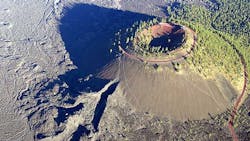Super Hot Rocks: Mazama Energy Trying to Harness Geothermal at Newberry Volcanic Site
Behold the volcanoes: They are magnificent, fascinating, evolving and terrifying landscapes in the topographical mindset of humankind.
They can crush everything around them—Pompeii, any one?—and yet, to quote filmmaker Werner Herzog his documentary “Into the Inferno,” they help create the atmosphere needed for breathing.
Perhaps they can also supply a clean and abundant energy resource for the future. Mazama Energy has started working on a new demonstration project to test the feasibility of advanced geothermal near the Newberry Volcano in Oregon.
The company is testing whether it can create a “Super-Hot Rock Enhanced Geothermal System” (EGS) through the demonstration. Super-Hot Rock refers to rocks having a temperature of 375°C (707 degrees Fahrenheit) or greater with the ability to provide more power density as compared to lower temperature rock upon extraction.
“The purpose of the Newberry SHR Demonstration project is to show that the new technology developed by Mazama Energy will enable the economic extraction of heat from the earth in locations where it was considered not possible so far,” Alain Bonneville, Chief Geoscientist for Mazama Energy, said in a statement. “This demonstration project will benefit from an important support of the U.S. Department of Energy and be conducted in close collaboration with Oregon State University and several national research institutions.”
The project will test several technologies to be deployed in two new deep wells planned to be drilled in super-hot rocks in 2025 and 2026. It aims to demonstrate a commercially viable geothermal reservoir created in super-hot rocks.
The heat recovery is required to be engineered by EGS as the rocks are naturally impermeable.
While initial work at the site began in August, it considered an existing 10,000 ft deep well. The work will extend until the end of this month.
See EnergyTech's Full Coverage of Geothermal Projects
Earlier this year, Mazama Energy was one of three geothermal companies granted funding to aid in developing enhanced geothermal technology. The $60 million award by the Department of Energy also included Chevron New Energies and Fervo Energy.
According to studies by MIT, the Department of Energy, the U.S. Geological Survey and Google, EGS technology is expected to allow many GW of recoverable geothermal energy in the Western U.S. alone and potentially over 3,000 GW across the U.S.
A major challenge faced by EGS projects is the cost. It is important to increase the generation capacity of each well to make it more competitive on the open market for electricity as it lowers the cost of the produced power by reducing the number of wells required to be drilled.
The ability to create multiple stimulated zones from a single well, according to Mazama Energy, leads to an increased amount of power produced by the well, and decreases the overall cost of the power produced.
Newberry volcano is calculated to have last erupted around 690 AD, according to the Smithsonian Institution’s Global Volcanism Program. It is topped by a massive caldera, four by five miles wide, which is big enough to contain two lakes.
Since 2022, Canadian researchers have explored the geothermal potential on the nation’s west coast around the rugged Garibaldi Volcanic Belt.
About the Author
Rod Walton, EnergyTech Managing Editor
Managing Editor
For EnergyTech editorial inquiries, please contact Managing Editor Rod Walton at [email protected].
Rod Walton has spent 17 years covering the energy industry as a newspaper and trade journalist. He formerly was energy writer and business editor at the Tulsa World. Later, he spent six years covering the electricity power sector for Pennwell and Clarion Events. He joined Endeavor and EnergyTech in November 2021.
Walton earned his Bachelors degree in journalism from the University of Oklahoma. His career stops include the Moore American, Bartlesville Examiner-Enterprise, Wagoner Tribune and Tulsa World.
EnergyTech is focused on the mission critical and large-scale energy users and their sustainability and resiliency goals. These include the commercial and industrial sectors, as well as the military, universities, data centers and microgrids. The C&I sectors together account for close to 30 percent of greenhouse gas emissions in the U.S.
He was named Managing Editor for Microgrid Knowledge and EnergyTech starting July 1, 2023
Many large-scale energy users such as Fortune 500 companies, and mission-critical users such as military bases, universities, healthcare facilities, public safety and data centers, shifting their energy priorities to reach net-zero carbon goals within the coming decades. These include plans for renewable energy power purchase agreements, but also on-site resiliency projects such as microgrids, combined heat and power, rooftop solar, energy storage, digitalization and building efficiency upgrades.

